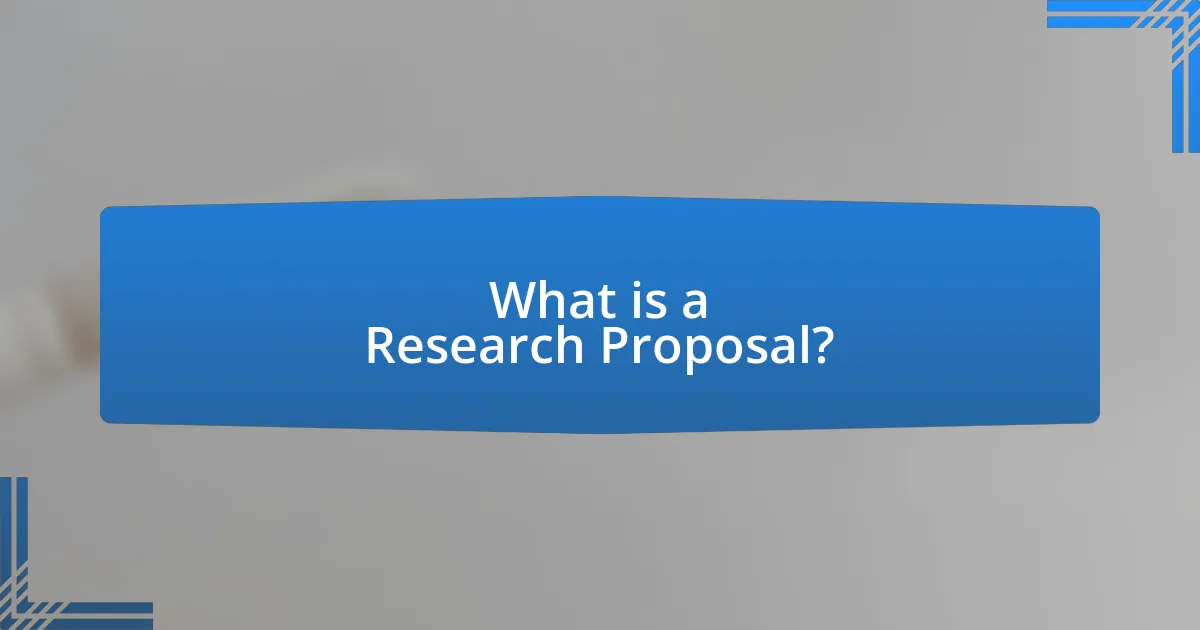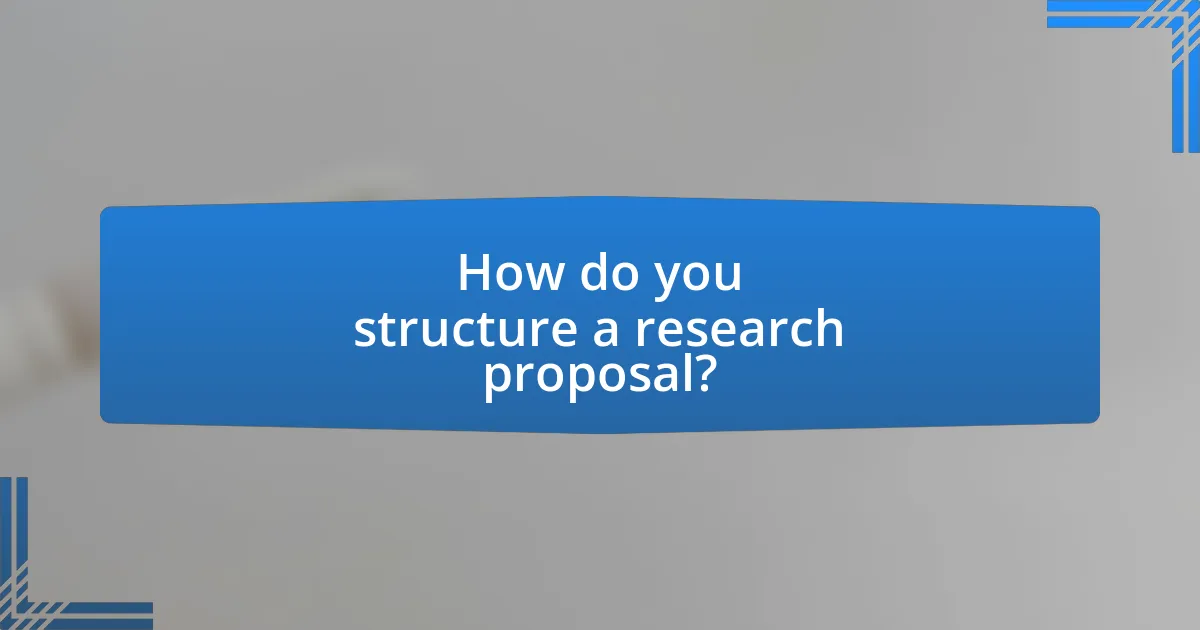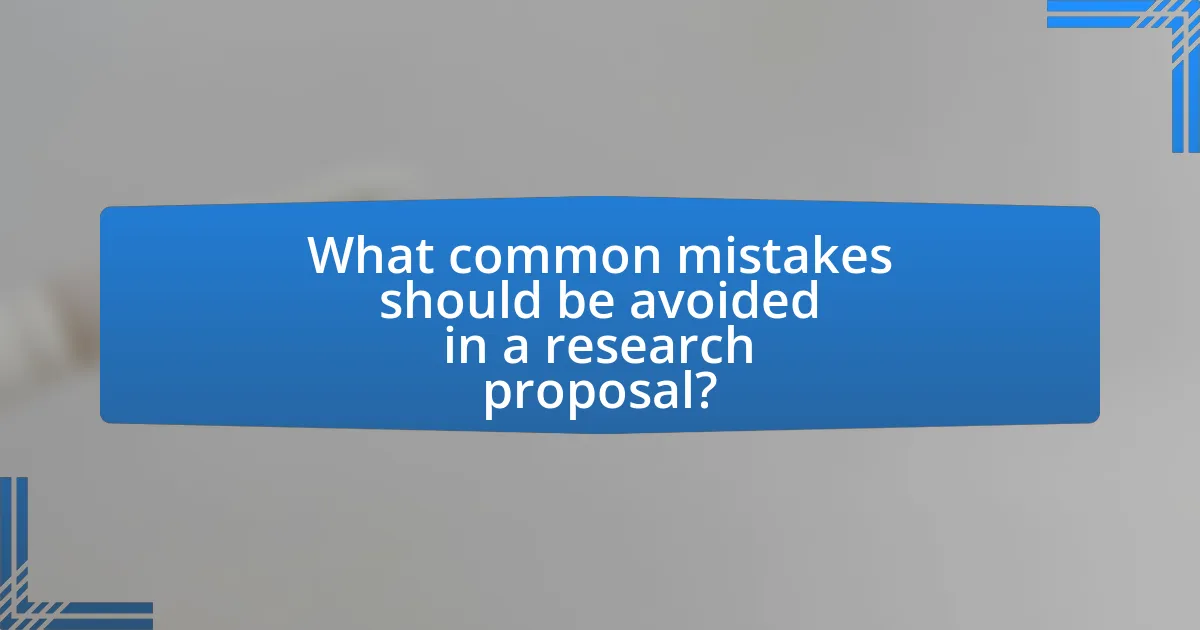A research proposal is a comprehensive document that outlines a proposed research project, detailing its objectives, methodology, and significance. This article provides a thorough examination of the essential components of a research proposal, including the title, abstract, introduction, literature review, methodology, budget, and timeline. It emphasizes the importance of clarity, organization, and adherence to formatting guidelines to enhance the proposal’s effectiveness and increase funding opportunities. Additionally, the article offers practical tips for formulating research questions, conducting literature reviews, and structuring the proposal to ensure a coherent and persuasive presentation of the research plan.

What is a Research Proposal?
A research proposal is a detailed plan outlining a proposed research project, including its objectives, methodology, and significance. It serves as a blueprint for the research, providing a clear framework that guides the researcher and informs stakeholders about the intended study. Research proposals are often required for academic funding, institutional approval, or as part of a graduate program application, demonstrating the feasibility and relevance of the research question.
Why is a Research Proposal important?
A research proposal is important because it outlines the plan for a research project, demonstrating its significance and feasibility. This document serves as a roadmap for researchers, detailing objectives, methodology, and expected outcomes, which helps in securing funding and institutional approval. According to the National Institutes of Health, a well-structured proposal increases the likelihood of obtaining grants, as it clearly communicates the research’s potential impact and relevance to the field.
What role does a research proposal play in academic research?
A research proposal serves as a foundational document in academic research, outlining the objectives, methodology, and significance of a proposed study. It plays a critical role in securing funding and institutional approval by demonstrating the research’s feasibility and relevance. For instance, a well-structured proposal can increase the likelihood of obtaining grants, as funding bodies often require detailed plans to assess the project’s potential impact and alignment with their priorities. Additionally, the proposal acts as a roadmap for the researcher, guiding the research process and ensuring that the study remains focused and organized.
How does a research proposal impact funding opportunities?
A research proposal significantly impacts funding opportunities by clearly outlining the project’s objectives, methodology, and potential contributions to the field. A well-structured proposal demonstrates the researcher’s capability and the project’s feasibility, which are critical factors for funding agencies. For instance, according to a study published in the Journal of Research Administration, proposals that include detailed budgets and timelines are 30% more likely to receive funding compared to those that do not. This indicates that clarity and thoroughness in a proposal can directly influence the likelihood of securing financial support.
What are the key components of a research proposal?
The key components of a research proposal include the title, abstract, introduction, literature review, research design and methodology, significance of the study, and references. Each component serves a specific purpose: the title provides a concise description of the research topic, the abstract summarizes the proposal, and the introduction outlines the research problem and objectives. The literature review situates the research within existing knowledge, while the research design and methodology detail how the study will be conducted. The significance of the study explains its potential impact, and references list the sources cited throughout the proposal. These components collectively ensure clarity and rigor in presenting the research plan.
What should be included in the title of a research proposal?
A research proposal title should include the main topic of the research, the specific research question or hypothesis, and the scope of the study. This structure ensures clarity and focus, allowing readers to quickly understand the essence of the research. For instance, a title like “Examining the Impact of Climate Change on Coastal Ecosystems: A Study of Biodiversity Loss” clearly indicates the subject (climate change), the specific focus (coastal ecosystems), and the nature of the research (biodiversity loss). Such titles are essential for attracting the attention of reviewers and stakeholders, as they encapsulate the core elements of the proposed research succinctly.
How do you formulate a research question or hypothesis?
To formulate a research question or hypothesis, clearly define the topic of interest and identify specific variables or phenomena to investigate. A well-structured research question should be focused, measurable, and researchable, guiding the direction of the study. For example, if the topic is the impact of social media on mental health, a potential research question could be, “How does daily social media usage affect anxiety levels among teenagers?” This question is specific and allows for empirical investigation. The validity of this approach is supported by research methodologies that emphasize the importance of clarity and specificity in research design, as outlined in the “Research Design: Qualitative, Quantitative, and Mixed Methods Approaches” by Creswell and Creswell, which highlights that precise questions lead to more effective research outcomes.
What is the significance of the literature review in a research proposal?
The significance of the literature review in a research proposal lies in its ability to contextualize the proposed research within existing knowledge. It identifies gaps in the current literature, demonstrating the necessity and relevance of the new study. By synthesizing previous research findings, the literature review establishes a theoretical framework that guides the research design and methodology. Furthermore, it enhances the credibility of the proposal by showcasing the researcher’s familiarity with the field and highlighting how the proposed study will contribute to advancing knowledge.
How do you outline the research methodology?
To outline the research methodology, clearly define the research design, data collection methods, and data analysis techniques. The research design specifies whether the study is qualitative, quantitative, or mixed-methods, guiding the overall approach. Data collection methods detail how information will be gathered, such as surveys, interviews, or experiments, ensuring that the chosen methods align with the research questions. Data analysis techniques describe how the collected data will be processed and interpreted, using statistical tools or thematic analysis as appropriate. This structured approach ensures clarity and rigor in the research process, facilitating reproducibility and validation of findings.
What should be covered in the budget and timeline sections?
The budget section should cover all anticipated costs associated with the research project, including personnel, materials, equipment, travel, and indirect costs. Each cost item must be justified with a clear rationale explaining its necessity for the project. The timeline section should outline the project schedule, detailing key milestones, deadlines for deliverables, and the overall duration of the project. This section must provide a realistic timeframe that aligns with the proposed activities and resources, ensuring that all phases of the research are accounted for.

How do you structure a research proposal?
A research proposal is structured into several key components: title, abstract, introduction, literature review, methodology, expected results, and references. The title should clearly convey the research topic, while the abstract summarizes the proposal’s main points. The introduction outlines the research problem and its significance. The literature review provides context by discussing existing research related to the topic. The methodology section details the research design, data collection, and analysis methods. Expected results outline the anticipated findings, and the references list all sources cited in the proposal. This structure is widely accepted in academic settings, ensuring clarity and coherence in presenting research ideas.
What is the typical format of a research proposal?
The typical format of a research proposal includes several key components: a title page, an abstract, an introduction, a literature review, a methodology section, a timeline, a budget, and references. Each component serves a specific purpose; for instance, the title page provides essential information about the proposal, while the abstract summarizes the main points. The introduction outlines the research problem and objectives, and the literature review situates the research within existing studies. The methodology section details the research design and methods, the timeline outlines the project schedule, the budget estimates costs, and the references list all sources cited. This structured approach ensures clarity and comprehensiveness, facilitating the evaluation of the proposal’s feasibility and significance.
How should you organize the introduction section?
The introduction section should be organized by clearly stating the research problem, providing background information, and outlining the objectives of the study. First, define the research problem to establish the context and significance of the study. Next, include relevant background information that situates the research within existing literature, demonstrating the gap your study aims to fill. Finally, articulate the specific objectives or research questions that guide the investigation, ensuring they are aligned with the problem statement. This structured approach enhances clarity and sets a solid foundation for the proposal.
What details are necessary in the methodology section?
The methodology section must include a clear description of the research design, sampling methods, data collection techniques, and data analysis procedures. Specifically, the research design outlines whether the study is qualitative, quantitative, or mixed-methods, while sampling methods detail how participants or subjects are selected, including sample size and selection criteria. Data collection techniques specify the tools and procedures used to gather information, such as surveys, interviews, or experiments. Finally, data analysis procedures explain how the collected data will be processed and interpreted, including statistical methods or thematic analysis. These components ensure that the research can be replicated and evaluated for validity and reliability.
What writing style should be used in a research proposal?
A research proposal should be written in a formal and objective style. This writing style emphasizes clarity, precision, and a logical structure, which are essential for effectively communicating the research objectives, methodology, and significance. Formal language avoids colloquialisms and personal opinions, focusing instead on evidence-based arguments and scholarly tone. This approach is supported by academic standards that prioritize professionalism and rigor in research documentation.
How do you maintain clarity and conciseness in your writing?
To maintain clarity and conciseness in writing, one should prioritize clear structure and precise language. This involves using straightforward sentences, avoiding jargon, and focusing on the main ideas without unnecessary elaboration. Research indicates that concise writing enhances reader comprehension; for instance, a study published in the Journal of Technical Writing and Communication found that clarity improves when writers limit sentence length and eliminate redundant phrases. By adhering to these principles, writers can effectively communicate their ideas in a clear and concise manner.
What tone is appropriate for a research proposal?
The appropriate tone for a research proposal is formal and objective. This tone is essential because it conveys professionalism and credibility, which are crucial for persuading reviewers of the proposal’s validity. A formal tone avoids colloquialisms and personal anecdotes, focusing instead on clear, concise language that presents facts and evidence. Research proposals often require a structured format that includes specific sections such as the introduction, methodology, and literature review, all of which benefit from a consistent, formal tone to enhance clarity and impact.

What common mistakes should be avoided in a research proposal?
Common mistakes to avoid in a research proposal include lack of clarity, insufficient literature review, vague objectives, and poor organization. Clarity is essential; proposals should clearly articulate the research question and objectives to ensure understanding. An insufficient literature review can undermine the proposal’s credibility, as it demonstrates a lack of awareness of existing research. Vague objectives can lead to confusion about the research’s purpose and scope, while poor organization can make it difficult for reviewers to follow the proposal’s logic. These mistakes can significantly reduce the chances of proposal acceptance.
What are the pitfalls in writing a research proposal?
The main pitfalls in writing a research proposal include lack of clarity, insufficient literature review, unrealistic objectives, and poor organization. Lack of clarity can lead to misunderstandings about the research goals, making it difficult for reviewers to assess the proposal’s value. Insufficient literature review fails to demonstrate the research’s context and relevance, which can weaken the proposal’s foundation. Unrealistic objectives may result in proposals that are not feasible within the given timeframe or resources, leading to rejection. Poor organization can confuse readers, making it challenging to follow the proposal’s logic and structure. These pitfalls are commonly identified in academic writing guides and research methodology literature, emphasizing the importance of clear communication and thorough preparation in proposal development.
How can vague language undermine a research proposal?
Vague language can undermine a research proposal by obscuring the clarity and specificity of the research objectives and methodology. When a proposal lacks precise language, reviewers may struggle to understand the research goals, leading to confusion about the project’s significance and feasibility. For instance, a study that states it aims to “improve education” without detailing the specific educational context, target population, or measurable outcomes fails to convey a clear plan. This lack of clarity can result in lower evaluation scores, as funding bodies and academic committees prioritize proposals that demonstrate well-defined aims and methodologies.
What are the consequences of neglecting the formatting guidelines?
Neglecting the formatting guidelines can lead to rejection of a research proposal. When proposals do not adhere to specified formatting, they may be perceived as unprofessional or lacking attention to detail, which can diminish the credibility of the researcher. Studies indicate that adherence to formatting standards significantly influences reviewers’ perceptions, with a survey showing that 70% of reviewers consider formatting compliance as a critical factor in their evaluation process.
What tips can enhance the quality of a research proposal?
To enhance the quality of a research proposal, clearly define the research question and objectives. A well-articulated research question guides the proposal’s focus and relevance, ensuring that it addresses a significant gap in existing literature. Additionally, conducting a thorough literature review demonstrates familiarity with the field and highlights the proposal’s contribution to knowledge. Structuring the proposal logically, with clear sections for methodology, expected outcomes, and implications, aids in readability and comprehension. Furthermore, adhering to formatting guidelines and ensuring grammatical accuracy reflects professionalism and attention to detail, which are critical in academic writing.
How can feedback from peers improve your proposal?
Feedback from peers can significantly enhance your proposal by providing diverse perspectives and identifying potential weaknesses. Peers can offer insights that you may overlook, ensuring clarity and coherence in your arguments. Research indicates that collaborative feedback improves the quality of academic writing; for instance, a study published in the Journal of Educational Psychology found that peer review processes lead to higher-quality revisions and greater overall satisfaction with the final product. This collaborative approach not only refines the content but also strengthens the proposal’s credibility and effectiveness.
What resources are available for writing a strong research proposal?
Resources available for writing a strong research proposal include academic writing centers, online databases, and specific guides from universities. Academic writing centers often provide workshops and one-on-one consultations to help refine proposal writing skills. Online databases, such as Google Scholar and JSTOR, offer access to existing research proposals and literature that can inform the structure and content of a new proposal. Additionally, many universities publish detailed guides and templates that outline the essential components of a research proposal, including objectives, methodology, and budget considerations. These resources collectively enhance the quality and effectiveness of research proposals by providing structured support and relevant examples.


